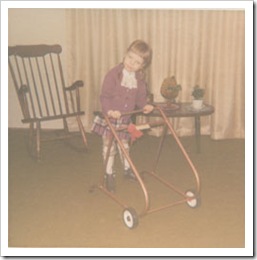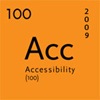Special Ed Class Provides Early Training for the Left Thumb Blogger
 Growing up with cerebral palsy, my school years began in a special education class annex several blocks the main school. Now that is segregation!
Growing up with cerebral palsy, my school years began in a special education class annex several blocks the main school. Now that is segregation!
But, at age five, I didn’t know the difference. I was excited to be starting Grade 1 with my friend Marika from Kindergarten and soon became friends with my four or five other classmates.
Our teacher Mrs. Rutherford was somewhat apprehensive having me in her classroom. As I share in my autobiography I’ll Do It Myself:
Being non-verbal, my teacher Mrs. Rutherford was concerned that she wouldn’t hear me when I needed help, so she gave me two small brass bells – her mom’s dinner bells – to ring to get her attention. It was soon discovered that the bells weren’t necessary as I was verbal enough to catch her attention when needed.
The bells were soon buried in my desk drawer and Mrs. Rutherford was well on her way to mastering Glenda-ish. The learning for both the student and the teacher continued…
Because getting to the chalkboard was difficult for most of us once we were placed in our seats, we each had an 18-inch square piece of chalkboard at our desks for practicing our printing. It was also easier to work on a horizontal surface rather than a vertical one. Initially, my printing was wobbly scribbles. With practice and extreme concentration, I controlled my jerky movements enough to make my letters almost legible more of the time. I also kept a chalk eraser handy, though inadvertently an uncontrollable movement erased a good letter. In frustration, I did the letter again.
Although learning to print, and then to write, were important steps in learning to read, it was evident that printing would not be efficient. It took too much energy and was too time-consuming to keep up with my work, and that would only worsen through the grades. Learning to use a typewriter was a necessity.
An electric Smith Corona typewriter was placed at the back of the room, which a few of us shared. When it was time to do typewriter work, Mrs. Rutherford dragged me in my desk chair over to the typewriter table and then dragged me back to my desk when I was done. Then it was the next student’s turn. A while later, perhaps once funding became available, we each had a typewriter at a second desk beside us. We simply dragged the typewriter back and forth as we needed it. It was much easier, especially on Mrs. Rutherford’s back.
As I have only one somewhat functioning hand, I only typed with one hand, my left hand. While typing, I steadied my hand on the typewriter hood to give myself some control over the spastic movements and used my thumb to hit the keys, causing my wrist to be in a dropped-wrist position. This concerned the adults, particularly the physio and occupational therapist. Although this was decades before repetitive strain injury and carpal tunnel syndrome had been invented, they were concerned that the dropped-wrist position would cause damage over the long-term.
They decided a splint with a stick to hit the keys was needed to keep my wrist in a good position. With this contraption snuggly Velcro strapped to my arm, I was expected to have enough arm control to steady my hand mid-air, without resting it on anything, and to accurately hit the keys. And this was less frustrating than printing with a pencil? After a few days, the splint ended up in the back of my desk drawer, and I resumed typing with my left thumb, my hand in its compromising position. I type the same way today, as nothing else feels as natural. For a non-verbal individual who relies on written communication, my left thumb is my most valued body part.
 A Smith Corona electric typewriter with a keyguard still occupies desk space. This how I fill out cheques, forms and other such tasks that cannot be completed on the computer.
A Smith Corona electric typewriter with a keyguard still occupies desk space. This how I fill out cheques, forms and other such tasks that cannot be completed on the computer.
The typewriter in this photo is my second. The motor on my first, an even earlier Smith Corona model, eventually blew up!
Who knew the learning to type at the age of five would eventually lead me to becoming known as the Left Thumb Blogger!
Previous miniseries post: Catching the Back to School Fever: Launching a Mini Series on My Years from Special Ed Class to University
Next miniseries post: Excuse Me If I Lay on the Floor When We Meet
If you enjoyed this post, consider buying me a chai tea latte. Thanks kindly.


 Subscribe via RSS
Subscribe via RSS



